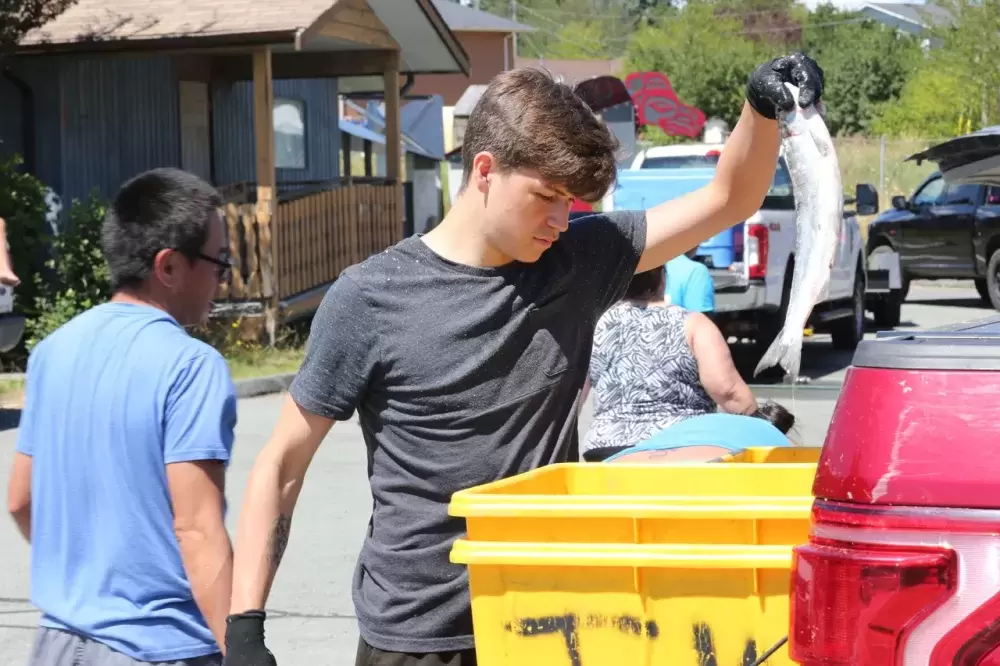The Tseshaht ended up with a sockeye fishery this year, but did so without signing an agreement with DFO to catch and sell salmon from the Somass River.
For most of the last 20 years the First Nation has made an economic opportunity agreement with Fisheries and Oceans Canada, enabling the Tseshaht to catch according to a predetermined quota and sell sockeye from their territorial river to commercial buyers. This year the sockeye run initially looked bleak with just 168,788 reaching the Somass River from the Pacific – not nearly enough to sustain any fisheries. Tseshaht agreed to closures based on this pre-season forcast.
But the return was adjusted to 250,000 on June 25, allowing First Nations, recreation and commercial fisheries to open by Canada Day. The expected sockeye run was further upgraded to 300,000 by mid-July in the last days of fishing.
Under DFO’s management plan, this brought an allocation of 13,000 sockeye for the sports fishery, while the Tseshaht and Hupacasath First Nations shared an allotment of 20,800.
The Tseshaht never agreed to these allocations, according to Hugh Braker, a councillor for the First Nation who is responsible for fisheries negotiations, as it amounts to less than 15 sockeye per member for the year.
“We are strongly of the view that such an allocation does not reflect the importance of salmon to the Tseshaht, the needs of the Tseshaht or the Aboriginal title and rights of the Tseshaht,” wrote Braker to Bernadette Jordan, Canada’s minster of Fisheries and Oceans. “We believe that in times of low returns, our access to salmon is compromised and our rights are placed second to the commercial and recreational fisheries.”
In his July 14 letter Braker requests a meeting with either Jordan or the DFO’s regional director general for the Pacific region to discuss Tseshaht fisheries “as soon as possible to avoid further conflicts in our relationship.”
Conflict became apparent in correspondence the First Nation received from Peter Hall, a salmon and herring coordinator with Fisheries and Oceans, who stressed the importance of cooperation with First Nations as fisheries prepare for the chinook harvest in mid August.
“[Economic opportunity] agreements are meant to be for several salmon species and be in place for the whole salmon season, and the decision-making process considers each nation separately,” wrote Hall to the Tseshaht. “This means that an agreement may be entered with only one nation if that is required to manage the fisheries.”
This suggestion that the Tseshaht could be left out of future agreements is “paternalistic, patronizing, condescending and colonial,” stated Braker.
“Mr. Hall is (and by implication DFO) we believe saying, in effect, ‘be good First Nations, or else DFO will take away your right to fish for sale and earn income’,” he wrote to the fisheries minister. “Tseshaht finds it impossible to sit at a table with DFO officials who practice paternalism towards Aboriginal people.”
Instead of operating under an economic opportunity agreement, the Tseshaht fished according to their Aboriginal right, which is protected by the Canada’s Constitution. Sockeye were sold by members on the side of the road, activity that is technically legal under Canadian law, said Tseshaht Fisheries Manager Dave Rolston. He points to the Marshall decision from 1999, when the Supreme Court of Canada ruled that First Nations fishing for food, social and ceremonial purposes includes the “right to a moderate livelihood” by selling this harvest.
“The economic opportunity agreement is somewhat problematic in a number of ways,” explained Rolston.
“When they sign an economic opportunity agreement, DFO rolls [food, social and ceremonial] and EO fish - or commercial fish - together under one quota, and then we basically have to share that quota with the Hupacasath First Nation, who are considerably smaller,” he continued. “That doesn’t address FSC needs for this community.”
Case law has ruled that First Nations food, social and ceremonial fishing has priority above other groups, and is second only to conservation of the stocks. By following this priority access, the Tseshaht harvested over 25,000 adult sockeye this summer, with 11,000-12,000 jacks.
Rolston said the Tseshaht have continued to contribute to the tracking of the sockeye run size, which is calculated through a combination of data, including test fishing boats, catch records and fish counting at designated locations.
“We’re not holding back reporting our numbers, but if there is a conservation concern, you’ve got to shut down sport and commercial before you shut down First Nations FSC fisheries,” said Rolston. “That hasn’t happened, therefore there is no conservation concern yet.”
The sockeye were harvested through a widespread community involvement in the fishery, a participation that is only expected to increase when the chinook reach the Somass in August. At least 100 Tseshaht members financially subsist on fishing, while another 150 supplement their main source of income by harvesting from the river they have lived off of for thousands of years.







